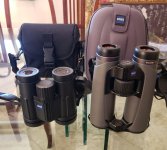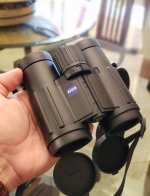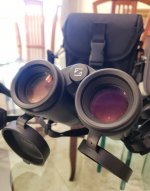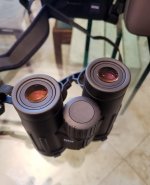For serious field use (I used to be a field biologist), weight is more important to me than size, so I still see the value of the 32mm SF as trying to do the most with that objective size, and I have the 10x32. For casual use - i.e. throwing in a bag as you're heading out the door, or wearing for opportunistic viewing as your wandering around town, something really compact and unobtrusive is important, and for me 25mm binoculars are just too fiddly and unstable. I'd love a pair of 8x32 to complement my larger 10x main binoculars, but I've never been able to justify the price of the FL for this kind of 2nd-tier use. Maybe if some start turning up at reduced close-out prices . .
-
Welcome to BirdForum, the internet's largest birding community with thousands of members from all over the world. The forums are dedicated to wild birds, birding, binoculars and equipment and all that goes with it.
Please register for an account to take part in the discussions in the forum, post your pictures in the gallery and more.
You are using an out of date browser. It may not display this or other websites correctly.
You should upgrade or use an alternative browser.
You should upgrade or use an alternative browser.
Zeiss 8x32 FL T* Owners VS Possible Up Grade To The Zeiss 8x32 Victory SF 8x32 (2 Viewers)
- Thread starter gcole
- Start date
More options
Who Replied?pbjosh
missing the neotropics

If you're not keen on a 25mm bin, there are two clear options, at least in my opinion, for what you describe - the two top 8x30 bins, the Swaro CL-B and the Nikon MHG. There are myriad threads on them here, they are both excellent, and they're even a good notch smaller and lighter than the 32mm FL or UVHD. For me they are the "smallest/most compact" bin that still feels more or less like a full sized bin and delivers more or less alpha level performance.For serious field use (I used to be a field biologist), weight is more important to me than size, so I still see the value of the 32mm SF as trying to do the most with that objective size, and I have the 10x32. For casual use - i.e. throwing in a bag as you're heading out the door, or wearing for opportunistic viewing as your wandering around town, something really compact and unobtrusive is important, and for me 25mm binoculars are just too fiddly and unstable. I'd love a pair of 8x32 to complement my larger 10x main binoculars, but I've never been able to justify the price of the FL for this kind of 2nd-tier use. Maybe if some start turning up at reduced close-out prices . .
I have the 8x30 Nikon MHG. To my mind, they're still a step down from the real alphas, particularly in terms of the fussiness of eye placement, but I got a pair refurbished direct from Nikon for only $500 and some change, so they play that role of compact, inexpensive, go-anywhere binocular for me. I also have a pair of 8x30 Eii, and I prefer the view through those, but they're not as light or convenient to carry around (mostly due to lack of waterproofing and the annoying hang angle).If you're not keen on a 25mm bin, there are two clear options, at least in my opinion, for what you describe - the two top 8x30 bins, the Swaro CL-B and the Nikon MHG. There are myriad threads on them here, they are both excellent, and they're even a good notch smaller and lighter than the 32mm FL or UVHD. For me they are the "smallest/most compact" bin that still feels more or less like a full sized bin and delivers more or less alpha level performance.
eitanaltman
Well-known member
Man you all are speaking my language right now.
Like Brummie said, for serious field use, where the binoculars will be worn out ready for use, the weight is a much bigger factor than size. Size really matters when you're packing, like for space-constrained travel or casual "throw it in the bag" use.
When I'm birding, my binoculars are out and ready to go, and I'm fine with a large 32mm (my EDG 10x32 are my most used binoculars and the pair I chose to take with me to Oaxaca earlier a few weeks ago).
I just got a pair of Zeiss Victory 8x25 and the optics are first rate, truly "mini alphas", but even these still have the fussy handling of a compact for me, at least at initial use. The tiny eyecups + long eye relief + small body means I have to work a bit to keep them aligned to my eyes, so they are almost more fatiguing to use hand-held than a larger binocular that I can hold more naturally.
I'm thinking I may need to try the 8x30 Monarch HG. I really didn't like the ergos of the 8x30 Swaro CL and I'm sensing that Zeiss 8x25 won't be comfy enough for that "compact / go-anywhere but still has good optics/handling" role for me. I actually love the ergos of the GPO 32mm but the optics are not quite at the level that I'm hoping for. Maybe I need to try the Opticron Traveler ED?
Actually, since I had the Swaro 8x30 CL-B and have the UVHD 32mm, I need to point out that the Swaro CL is NOT smaller than the 32mm UVHD. The barrels are slimmer and it weighs a bit less (on my scale it's ~475g vs ~530g) but the Leica is significantly more compact in terms of length. You can see in this photo how short the 32mm UV is and how the 30mm CL is almost as long as the much bulkier/heavier Kowa Genesis 33 or Zeiss Conquest HD 32.
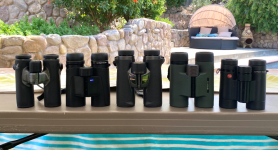
Like Brummie said, for serious field use, where the binoculars will be worn out ready for use, the weight is a much bigger factor than size. Size really matters when you're packing, like for space-constrained travel or casual "throw it in the bag" use.
When I'm birding, my binoculars are out and ready to go, and I'm fine with a large 32mm (my EDG 10x32 are my most used binoculars and the pair I chose to take with me to Oaxaca earlier a few weeks ago).
I just got a pair of Zeiss Victory 8x25 and the optics are first rate, truly "mini alphas", but even these still have the fussy handling of a compact for me, at least at initial use. The tiny eyecups + long eye relief + small body means I have to work a bit to keep them aligned to my eyes, so they are almost more fatiguing to use hand-held than a larger binocular that I can hold more naturally.
I'm thinking I may need to try the 8x30 Monarch HG. I really didn't like the ergos of the 8x30 Swaro CL and I'm sensing that Zeiss 8x25 won't be comfy enough for that "compact / go-anywhere but still has good optics/handling" role for me. I actually love the ergos of the GPO 32mm but the optics are not quite at the level that I'm hoping for. Maybe I need to try the Opticron Traveler ED?
If you're not keen on a 25mm bin, there are two clear options, at least in my opinion, for what you describe - the two top 8x30 bins, the Swaro CL-B and the Nikon MHG. There are myriad threads on them here, they are both excellent, and they're even a good notch smaller and lighter than the 32mm FL or UVHD.
Actually, since I had the Swaro 8x30 CL-B and have the UVHD 32mm, I need to point out that the Swaro CL is NOT smaller than the 32mm UVHD. The barrels are slimmer and it weighs a bit less (on my scale it's ~475g vs ~530g) but the Leica is significantly more compact in terms of length. You can see in this photo how short the 32mm UV is and how the 30mm CL is almost as long as the much bulkier/heavier Kowa Genesis 33 or Zeiss Conquest HD 32.

Physics is physics. In good lighting, the 32mm SF will perform as well as any top tier 42mm aside from viewing ease comfort. The actual quality of the optics is like splitting hairs. The compact size of the FL is something many are looking for. Aside from the optics, you have to decide whether you want to pack a longer bino. The longer bino is also easier to hold steady, and doubly so due to the weight distribution on the SF. Now that this matters on an 8x.
If you buy the FL 8x32 and have regrets, I’m sure there will be plenty of people on the forum that will buy the second hand instrument from you (including myself) if you get yourself a good copy.
(including myself) if you get yourself a good copy.
If you buy the FL 8x32 and have regrets, I’m sure there will be plenty of people on the forum that will buy the second hand instrument from you
Last edited:
Conndomat
United States of Europe

...and the higher resolution...Physics is physics. In good lighting, the 32mm SF will perform as well as any top tier 42mm aside from viewing ease comfort...
Andreas
Conndomat
United States of Europe

I think the photoreceptor density on my retinal fovea cannot outresolve the center resolution on an alpha 8x32. YMMV.
The opening determines the resolution, with close binary stars you can see the differences, physics is physics ...
Andreas
pbjosh
missing the neotropics

Actually, since I had the Swaro 8x30 CL-B and have the UVHD 32mm, I need to point out that the Swaro CL is NOT smaller than the 32mm UVHD. The barrels are slimmer and it weighs a bit less (on my scale it's ~475g vs ~530g) but the Leica is significantly more compact in terms of length. You can see in this photo how short the 32mm UV is and how the 30mm CL is almost as long as the much bulkier/heavier Kowa Genesis 33 or Zeiss Conquest HD 32.
Good point - and my error! I haven't used/seen a UVHD 8x32 in a long time, and I don't pay a ton of attention as the eye relief is insufficient for me, by quite a bit. The 8x32 UVHD is a lovely binocular, shame about the eye relief for so many people!
pbjosh
missing the neotropics

I don't have eye-placement problems - and while I can look at the MHG vs my 42mm alphas (Swaro and Zeiss) and say "ok, these aren't QUITE optically at the same level" the fact is that in day to day use, they're very very close to alpha quality, at least for me with my vision and whatnot.I have the 8x30 Nikon MHG. To my mind, they're still a step down from the real alphas, particularly in terms of the fussiness of eye placement, but I got a pair refurbished direct from Nikon for only $500 and some change, so they play that role of compact, inexpensive, go-anywhere binocular for me. I also have a pair of 8x30 Eii, and I prefer the view through those, but they're not as light or convenient to carry around (mostly due to lack of waterproofing and the annoying hang angle).
I'm still super keen on the 8x32SF, and if the MHG hadn't worked out so well, I think I would have gotten an 8x32FL - something I've very often considered, but the MHG has largely tempered that.
Conndomat
United States of Europe

...That's not quite true...Binary stars are not a good example. Their resolution depends on eyesight and magnification. The eyes' resolving power at night is bad enough that the instrument resolution is no longer the determining factor.
http://www.hobby-astronomie.com/teleskope_optische_grundlagen.html#aufloesung ...sadly only in German...
"Resolution, also known as selectivity, is the ability of a telescope to represent closely adjacent details, for example double stars or planetary structures, as two objects. It increases with the opening of the telescope and depends solely on it."
I made the attempt myself ...
Telescope Takahashi 60 / 355mm, magnification 85x, Vixen Fluorite 102 / 900mm, magnification 85x ...
In the larger telescope I was able to separate double stars with the same magnification, which was not possible in the smaller Takahashi.
Andreas
P.S. Of course, that eyesight naturally plays a role...and unfortunately it makes little sense to enlarge a 60mm opening to 200x.
Last edited:
Mark9473
Well-known member

The reason is that when viewing at night (you mentioned double stars), the resolving power of the dark adapted eye is very poor. It may be something like 200 arc seconds. When you then use a 10x binocular to look at double stars, you're only going to resolve, at best, double stars that are 20 arc seconds apart. It then becomes irrelevant if the instrument itself has a resolution of 3 or 4 or 5 arc seconds.
One may be lucky and have a dark adapted resolution of 150 arc seconds, or unfortunate and have only 300 arc seconds. I may struggle to resolve a double star in my 10x42 alpha binocular, that someone else easily splits in cheap 8x32's.
That's also physics.
One may be lucky and have a dark adapted resolution of 150 arc seconds, or unfortunate and have only 300 arc seconds. I may struggle to resolve a double star in my 10x42 alpha binocular, that someone else easily splits in cheap 8x32's.
That's also physics.
In my case, the orders were different
After months of buying Zeiss Victory SF 8x42 and me
delighted with the quality of the lenses and all the benefits that Victory SF offers
I ended up buying Zeiss Victory T * FL 8x32
I tell you, I was lucky to have found this binocular
The person bought the Zeiss Victory T * FL 8x32 auction lot from the Federal Police here in Brazil, with other items of interest, but the binoculars were not interesting for him and Zeiss was unused for 15 years, put them on a shelf and never put the binocular to work
So he decided to sell, I found him by luck
Zeiss is like new, the bag smells like new, the binocular has no wear mark, the lenses are flawless
I was very happy with the purchase.
All of this at a cost of $ 600
After months of buying Zeiss Victory SF 8x42 and me
delighted with the quality of the lenses and all the benefits that Victory SF offers
I ended up buying Zeiss Victory T * FL 8x32
I tell you, I was lucky to have found this binocular
The person bought the Zeiss Victory T * FL 8x32 auction lot from the Federal Police here in Brazil, with other items of interest, but the binoculars were not interesting for him and Zeiss was unused for 15 years, put them on a shelf and never put the binocular to work
So he decided to sell, I found him by luck
Zeiss is like new, the bag smells like new, the binocular has no wear mark, the lenses are flawless
I was very happy with the purchase.
All of this at a cost of $ 600
james holdsworth
Consulting Biologist
Amazing value there...they run close to $1500 in Canada...I’d snap those up in a second!
Nice FindIn my case, the orders were different
After months of buying Zeiss Victory SF 8x42 and me
delighted with the quality of the lenses and all the benefits that Victory SF offers
I ended up buying Zeiss Victory T * FL 8x32
I tell you, I was lucky to have found this binocular
The person bought the Zeiss Victory T * FL 8x32 auction lot from the Federal Police here in Brazil, with other items of interest, but the binoculars were not interesting for him and Zeiss was unused for 15 years, put them on a shelf and never put the binocular to work
So he decided to sell, I found him by luck
Zeiss is like new, the bag smells like new, the binocular has no wear mark, the lenses are flawless
I was very happy with the purchase.
All of this at a cost of $ 600
I can't let it go, incredible binoculars, I'm enjoying Zeiss Victory FL 8x32 too much, how lucky I am 🙋♂️Amazing value there...they run close to $1500 in Canada...I’d snap those up in a second!
Similar threads
Users who are viewing this thread
Total: 3 (members: 0, guests: 3)





